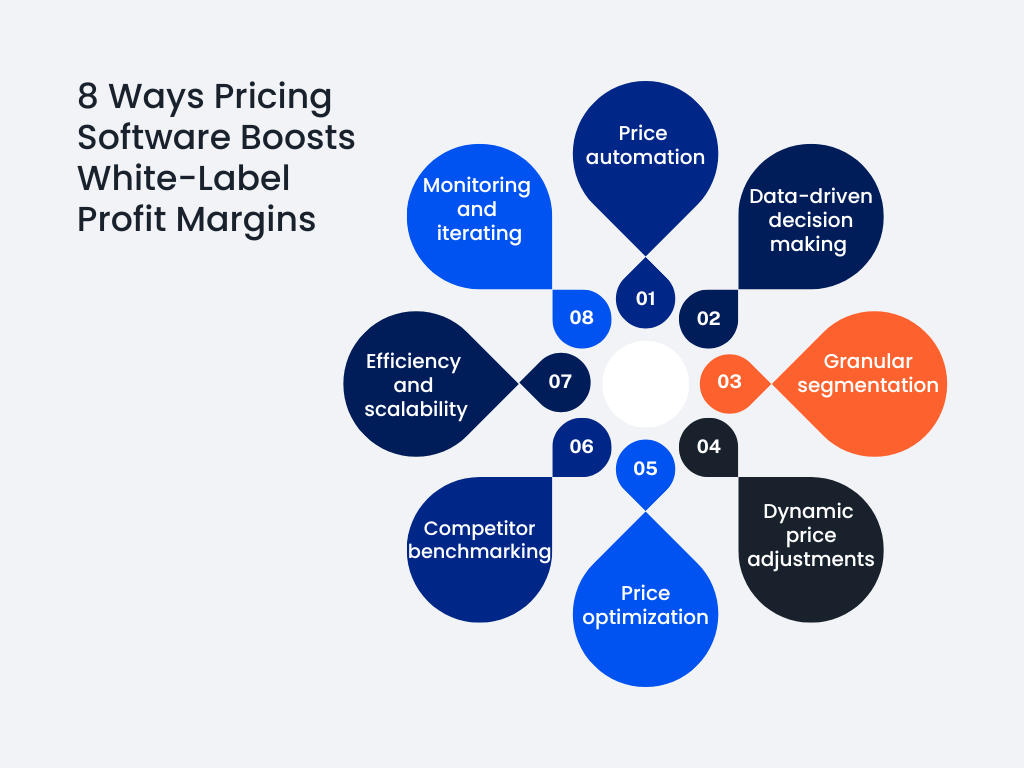BLOG
Pricing Precision: How Pricing Software Enhances White-Label Product Competitiveness
Discover the transformative power of pricing software in elevating your white-label product competitiveness through intelligent price setting.

AUTHOR
Anya Policht
DATE OF PUBLICATION
January 2024
TIME TO READ
5 minutes
Are you seeking ways to diversify your product catalog and increase profit margins? White-label products may be your answer.
White-label products are goods or services produced by one company but sold under another company's brand. The value lies in enabling a company to focus on its core competencies while still offering a diverse range of products under its brand. Many industries, including technology, cosmetics, food, and beverages, offer white-label products - but these often go unnoticed compared to well-known and trusted branded products.
Remaining competitive, therefore, requires careful pricing considerations. Pricing precision for white-label products is tricky, as you must effectively negotiate with manufacturers and consider market dynamics, consumer perceptions, and cost structures. But how can you take all these factors into account and devise the right pricing strategy to meet consumer and retailer expectations?
Enter pricing software, a powerful tool that enables you to navigate these complexities and redefine how you set prices for white-label products. As opposed to static prices, pricing software helps you stay on point - constantly determining the optimal price points that drive sales while maintaining a healthy profit margin.
Let’s explore the world of precision pricing for white-label products. We’ll uncover the challenges businesses face and how pricing software is a transformative tool that enhances your competitiveness in this dynamic market.
Challenges in White-Label Pricing
White-label products are gaining significant traction as businesses seek opportunities to expand their product offerings and increase profitability. According to Forbes, 87% of consumers now gravitate toward private-label grocery store items. Further, NielsenIQ’s data highlights an upward trend across 17 European countries where private label market share has impressively grown to 38.1% in 2022/2023. However, this burgeoning popularity has its challenges in the modern pricing world.
Aligning prices with branded products
Creating an effective white-label pricing strategy involves meticulous product alignment with branded counterparts. This requires you to match your white-label products individually with branded products and then index your price to maintain coherence and customer appeal. It’s common for customers to expect lower-priced white-label products, for example, 30% less than branded products, depending on the market positioning and other factors.
Absence of a distinct brand identity
Unlike branded products, white-label products often lack brand awareness. So, how do you determine market value for your white-label products without the backing of an established brand reputation? When setting prices, you must rely on a nuanced understanding of consumer expectations to gauge willingness to pay.
The danger of mispricing
An unestablished brand reputation presents two significant pitfalls: underpricing and overpricing. Underpricing your white-label products erodes their perceived value and ultimately, your profitability. Conversely, overpricing might alienate cost-conscious consumers and potentially hamper market adoption. That’s because overpriced items might lead customers to question product quality and the value they are getting for their money, nudging them toward other options. Therefore, striking a competitive price point is critical for white-label offerings.
The coexistence problem
Markets where white-label and branded products often coexist must align pricing strategies to prevent customer confusion and market share loss. A more calculated approach to white-label products is essential when you compete with branded alternatives.
Lacking accurate data for intelligent price setting
Accurate data and insights are critical for pricing precision. Lacking up-to-date information on market demands and private-label pricing trends can lead to guesswork or outdated metrics, resulting in missed opportunities or ineffective pricing strategies that fail to resonate with the target audience.
The Role of Pricing Software in Boosting White-Label Profit Margins
Pricing software is a comprehensive solution for your challenges in pricing white-label products and boosting profit margins. Let’s take a closer look into the untapped potential of pricing software and how it transforms white-label product profitability.

Price automation
Automating pricing decisions is a crucial advantage to swiftly adjust to changing market dynamics. You no longer need to rely on manual calculations and assumptions. Instead, sophisticated algorithms analyze many factors - production costs, desired profit margins, current market conditions, etc. - to ensure optimal financial gains.
Data-driven decision making
Modern pricing software like Pricemoov enables you to centralize and analyze extensive data from internal and external sources, including market trends, competitor pricing, and customer behavior. The resulting data-driven insights empower you to make informed pricing decisions for your white-label products. By accurately setting prices that resonate with market demands and customer expectations, you reduce the risks associated with underpricing or overpricing.
Granular segmentation
Segmenting white-label product prices by geographic regions or channels and following competitor prices is made simple with pricing software. This level of detailed analysis gives you added agility, as you can shift focus between different data sets - product-related data, competitor information, etc. - to fine-tune pricing quickly and efficiently.
Dynamic price adjustments
White-label products often face fluctuating market demands and competitive landscapes. With pricing software, you can quickly adjust prices according to changing demand, inventory levels, competitor pricing strategies, and more. This agility helps you maintain competitive and relevant pricing that adapts to market changes. Pricing software also identifies pricing opportunities such as demand peaks and competitor price gaps, so you can adjust your pricing strategy accordingly.
Price optimization
Pricing software uses advanced algorithms and business rules to optimize your white-label product pricing strategies. It allows you to easily identify the most effective price points that balance profitability and market share. You can also test various pricing scenarios through simulations and understand the potential impact on sales volume, revenue, and overall market positioning.
Competitor benchmarking
Conducting comprehensive competitor benchmarking is an essential pricing software function. By tracking and analyzing competitor prices, you can strategically position your white-label products to ensure optimal fares while offering distinct value propositions.
Efficiency and scalability
As you expand your product range or enter new markets, automating pricing processes boosts operational efficiency and scalability. Pricing software helps you manage pricing for your entire catalog of white-label products easily.
Monitoring and iterating
Having your finger on the pulse of the market is crucial for white-label product competitiveness. Pricing software supports continuous monitoring and iteration of your pricing strategies. This feature allows you to constantly evaluate price performance and iterate as needed to ensure an ongoing optimization process.
Maximizing Competitive Edge with Pricing Software in White-Label Retail
In the fast-paced and intensely competitive world of white-label products, you must harness every available resource to enhance your profit margins and secure a competitive advantage. Pricing software offers a powerful solution to unique challenges within the white-label product market by automating pricing processes, accessing accurate and up-to-date data, and gaining critical insights.
Utilizing pricing software empowers you to respond competitively to market shifts and proactively adjust prices on a more granular level. This technology significantly influences white-label product profitability by offering a suite of features from dynamic pricing adjustments to in-depth competitor analysis.
Within white-label retail, pricing software is mainly untapped and has immense potential. By embracing this technology, you can unlock new efficiency, accuracy, and strategic knowledge levels in your pricing strategies. The result is a tangible impact on profit margins and a more substantial market presence.
Ready to explore how pricing software can revolutionize your white-label product strategy and witness a remarkable elevation in your business performance? Contact us today and take the first step toward maximizing your profitability and competitive edge.




